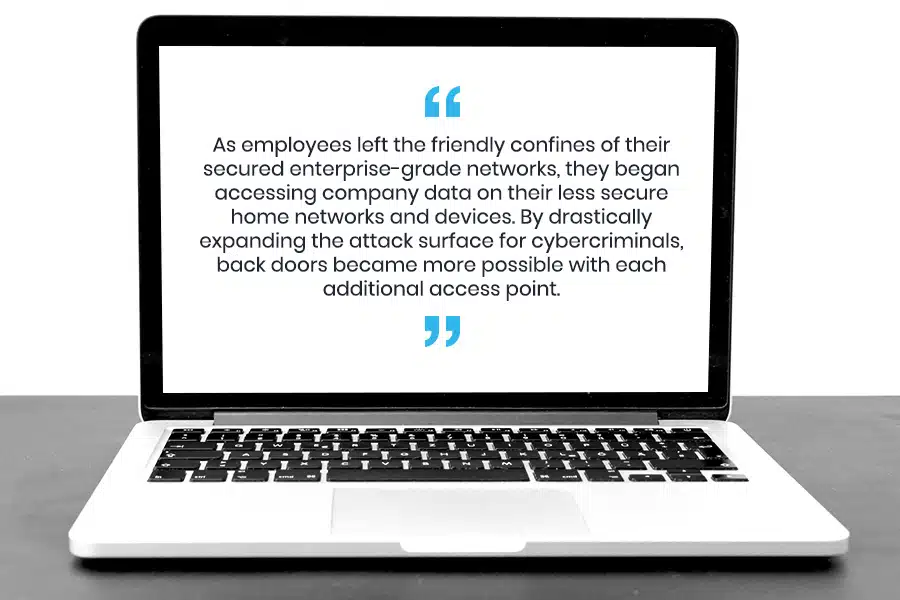This has been a year that tested our collective will and strength as never before. In a world reshaped by COVID-19, much about our world will likely never be the same.
Among its many effects, the pandemic has realigned the focus for IT as plans and priorities for businesses have had to shift overnight. As the world has been forced to reckon with the immense pressure of an international emergency, the technology that has propped up its most important infrastructure has had to adapt with it.
It’s crucial then for small to mid-sized businesses (SMBs) to understand how their world has changed, and what it means for their IT infrastructure heading into 2021. Let’s take a closer look at some of the top IT stories from 2020 and what they mean.
Working from Home Creates Greater Cyberattack Risk
Working from home stretched company networks over much larger physical distances than most have ever had to accommodate, with the added downfall of stretching those networks’ security protocols thin.
As employees left the friendly confines of their secured enterprise-grade networks, they began accessing company data on their less secure home networks and devices. By drastically expanding the attack surface for cybercriminals, back doors became more possible with each additional access point.
In fact, in an AT&T poll of 800 cybersecurity experts from the U.K., France, and Germany, 55% of respondents from small to mid-sized businesses said they believed they were more vulnerable to cyberattacks. That number jumped to 70% among businesses with 5,000 or more employees.
On top of that, the FBI reported in April that it was fielding up to 4,000 cybersecurity complaints a day, up from 1,000 before the pandemic.
The takeaway is that with employees continuing to work from home next year in some capacity, businesses should significantly bolster security protocols. That includes using a virtual private network (VPN), procuring work devices for work purposes and conducting cybersecurity training where needed.
5G Begins Its Rise as the New Global Standard
The advancement of technology was not completely hampered by an adjustment to the pandemic in 2020. Years in the making, 5G was finally rolled out on a large scale this year, making its way into a range of different devices and systems.
Mobile companies have accelerated the use of 5G in their networks and are placing a special focus on the technology in their marketing. Meanwhile, the Federal Communications Commission (FCC) is encouraging local governments to ramp up their network infrastructure to support new 5G-enabled services.
This burgeoning technology will continue to grow as do 5G-reliant technologies, like the internet of things (IoT), which is the whole network of devices, such as sensors and transmitters, that use the internet. For example, Cisco’s Annual Internet Report (2018-2023) reports that machine-to-machine connections will make up 50% of global connections by 2023, forecasting a boom in the IoT.
In sum, 5G technology is a buzzword in consumer tech, but its capacity allows businesses to reduce latency in cloud services that rely on perfectly reliable coverage to operate. It should also help SMBs save on operating costs because of the introduction of edge computing, which centralizes computation and storage closer to where information is being consumed.
Microsoft Teams Takes on Zoom
Zoom became the go-to service for videoconferencing at the beginning of the COVID-19 lockdown, but security breaches like “Zoombombing” began to plague the platform soon after it became popular. Meanwhile, Microsoft’s Teams platform has been overtaking market share throughout the year.
In April, Microsoft reported that Teams had jumped 44%, from 44 million daily users to 75 million. In late October, it reported another jump, from 75 million to 115 million daily users.
Microsoft continues to offer new features with an aim to be the most complete communications hub for businesses. Although some businesses are sticking with Zoom, Slack, Trello, and other collaboration apps, Teams has created a compelling solution by offering a single identity for companies through which Office 365 can be fully integrated and all their employees’ most common desktop applications. In this way, Teams combines videoconferencing, instant messaging, and file sharing, among many other functions, to offer the best all-in-one platform around.
Companies are on the move more than ever before, and Microsoft has sought to craft the most comprehensive hub available. As Teams continues to offer more user-requested features, businesses should expect to rely on Microsoft’s business solution for the long term.
Looking Ahead
An unprecedented global crisis has caused the world to scramble, forcing it to deal with urgent calamities instead of previously developed strategic plans. Businesses have had to reinvent themselves in the face of a scattered workforce, fighting off cyberattacks, preparing for 5G, and optimizing their use of Teams and Zoom as they’ve made their way through this year.
Hopefully, COVID-19 will be under control next year, but many challenges related to the pandemic will continue to face SMBs. However, 2021 will offer new opportunities to those that have proactively repositioned themselves for this new technology landscape.
At IT Support Guys, we remain ready for these challenges and encourage you to check our blog regularly to follow our insights on them.




